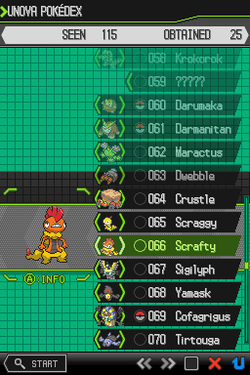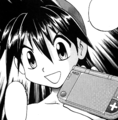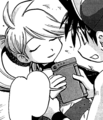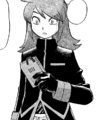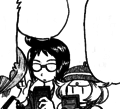Pokédex: Difference between revisions
m (→Intro) |
m (→Generation II) |
||
| Line 20: | Line 20: | ||
====Generation II==== | ====Generation II==== | ||
[[File:JohtoDex.png|thumb|left|Johto's Pokédex (model HANDY808), as seen in {{game|Gold and Silver|s|Pokémon Gold}}]] | [[File:JohtoDex.png|thumb|left|Johto's Pokédex (model HANDY808), as seen in {{game|Gold and Silver|s|Pokémon Gold}}]] | ||
[[Generation II]] retained the same elements as its predecessor, while adding the Pokémon's [[footprint]] to the information | [[Generation II]] retained the same elements as its predecessor, while adding the Pokémon's [[footprint]] to the information and, like Yellow, allowing players to print entries. Unlike Generation I, selecting a Pokémon displayed the entry in a new screen from which the other sections could be selected. This became the norm for each subsequent generation. | ||
In these games, entries that would normally display "Area Unknown" on the map simply displayed an unmarked map. | In these games, entries that would normally display "Area Unknown" on the map simply displayed an unmarked map. | ||
{{clear}} | {{clear}} | ||
====Generation III==== | ====Generation III==== | ||
[[File:PokedexHoennView.png|thumb|right|Viewing the Hoenn Pokédex in {{game3|Ruby and Sapphire|Pokémon Sapphire|s}}]] | [[File:PokedexHoennView.png|thumb|right|Viewing the Hoenn Pokédex in {{game3|Ruby and Sapphire|Pokémon Sapphire|s}}]] | ||
Revision as of 19:40, 30 March 2012
The Pokédex (Japanese: ポケモン図鑑 illustrated Pokémon encyclopedia) was created by Professor Oak as a invaluable tool to Trainers in the Pokémon world. It gives information about all Pokémon in the world that are contained in its database, although it differs in how it acquires and presents information over the different medias. However, they are also only given to a few Trainers at a time, generally to the ones that are felt to have exceptional potential and skill. There are different types of Pokédexes and each Pokédex is special to a specific region.
Pokédex entries are typically only two or three sentences in length, and are bits of information about the Pokémon referred to. In some events it gives background information on the habitat or activities of this Pokémon in the wild; at other times it gives other bits of information on the Pokémon's history or anatomy. The information included is important info on the Pokémon, height, weight (once obtained), cry, other forms, a few sentences about the Pokémon, and a picture of the Pokémon.
Functions
In order to accomplish Professor Oak's goal of a complete database of information on every Pokémon, the Pokédex is designed to find and record data on each Pokémon the Trainer meets. Pokémon are added to the Pokédex simply by encountering them in battle (or a few special exceptions in Gen IV, such as seeing a picture), but detailed entries are not recorded until the player catches the Pokémon or acquires it in a trade.
Entries
The main feature of any Pokédex are the entries on each individual Pokémon, which provide a lot of detail that would otherwise be unexplored in the games.
Generation I
In Generation I's Pokédex (model HANDY505), the entries were simple and each individual section could be accessed directly from the listing. The first, and main part, was called Data, and included an image of the Pokémon, its number, name, species, Height, Weight, and a short blurb. The second part was called Cry, and selecting that would simply play the Pokémon's cry. The last part was called Area, and would display the map, along with flashing indicators at each location where the selected Pokémon could be found. In cases where the Pokémon was not available in the wild, was only available once, or could only be found by fishing or in Cerulean Cave, the message "Area Unknown" would be displayed over the center of the map instead. The Yellow Version allowed players to print entries using the Game Boy Printer.
Generation II
Generation II retained the same elements as its predecessor, while adding the Pokémon's footprint to the information and, like Yellow, allowing players to print entries. Unlike Generation I, selecting a Pokémon displayed the entry in a new screen from which the other sections could be selected. This became the norm for each subsequent generation.
In these games, entries that would normally display "Area Unknown" on the map simply displayed an unmarked map.
Generation III
Generation III's Pokédex did not add anything to the main entry, however, Cry was given its own page, which would display the soundwave as it played. In addition, the Area section was changed to highlight locations instead of marking them and could now display the locations of Pokémon caught by fishing. A Size section was added, which displayed silhouettes of the Pokémon and the player character side by side.
FireRed and LeafGreen's Pokédex (model HANDY909) displayed entries in a much different format from Ruby, Sapphire and Emerald. It was the first Pokédex to actually display a Pokémon's type in its entry, as well as its box sprite. However, the Cry visuals were removed. Entries for Kanto Pokémon were taken from Red/Green for FireRed and Red/Blue for LeafGreen. Johto Pokémon entries were taken from Silver for FireRed and Gold for LeafGreen.
Generation IV
Generation IV's Pokédex (model HANDY910is) added numerous features, but of FireRed and LeafGreen's changes, it kept only Type. Area would now change its highlight color depending on whether a Pokémon is found on land or in water, and the player could view the differences between morning, day and night, with the default being the current time. Cry's display returned, with a bar display in addition to the wave display, and the ability to modify the cry via Chorus/Pan, Reverb/Filter and Loop. Weight was added to the Size section, which put the Pokémon and the player character on either side of a balance scale. A new Forms section allowed players to see gender and form differences within species, but only for forms they'd already seen.
HeartGold and SoulSilver changed the formatting again, now by displaying the list on the lower screen and the actual entry on the top screen. Cry's page was again removed. By selecting to view details, players could view Area, Size and Forms. Area no longer defaulted to the current time or differentiated between land and water, Size now utilized both screens to display both Height and Weight at the same time, and Forms added a Compare option to see different forms side by side instead of having to scroll between them. Entries for Johto and Kanto Pokémon were taken from Gold for HeartGold and Silver for SoulSilver. Also, while artwork shows a pink Pokédex for females, the in-game interface does not reflect this.
Generation V
The Generation V Pokédex is similar to the Pokédex from Pokémon Diamond, Pearl, and Platinum. It is displayed as a list on the right side of the lower screen with the selected Pokémon's sprite occuping the left side. Most of its functions are also similar to Generation IV's. Instead of showing the time of day that a Pokémon can be caught, as in Generation IV, the Pokédex shows the seasons in which it can be found. Areas in which the Pokémon can be found flash red, and touching an area will show the methods by which it can be caught (walking in tall grass, surfing, or fishing). The height and weight comparison feature has been removed, but a section showing form differences and a search feature are added by Cedric Juniper when the player visits Mistralton City. The form difference section will now show Shiny Pokémon as well as form differences. The last sprite selected will become the one displayed in the main entry. If the player obtains a Pokémon from another country, they can select a language for that Pokémon's entry. The cry page has been added again as well.
Extra Pokédex skins can also be downloaded through the Pokémon Global Link.
Search and order
The original Pokédex had no search function.
In Generation II, the ability to search for Pokémon by type was added, as well as the ability to sort by New Pokédex mode, Old Pokédex mode, A to Z mode and Unown mode.
In Ruby and Sapphire, the search function was expanded to allow searches by name and color. Players were also given the option to order Pokémon by Heaviest, Lightest, Tallest, or Smallest. Two modes were available, Hoenn and National. National mode was unlocked via a trade with Kanto or Orre, or in Emerald, defeating the Elite Four.
However, in FireRed and LeafGreen, the search function was dropped altogether, instead choosing to expand the sort functions by adding lists of Pokémon by type and habitat. Heaviest and Tallest orders were also removed. National Mode was unlocked by having obtained 60 Pokémon in the Pokédex and beating the Elite Four.
Generation IV brought the Search function back, as well as Heaviest and Tallest orders. Habitat was dropped. Searches could now be conducted by Form, but not by Color. The two Pokédex modes were Sinnoh and National. National mode was unlocked by seeing every Pokémon in the Sinnoh Dex.
HeartGold and SoulSilver added the ability to search by Height and Weight (instead of simply sorting by them), and also allowed search by Area (Johto, Kanto, or Unknown). National Mode was added by talking with Professor Oak in the S.S. Aqua port in Olivine City after defeating the Elite Four.
In Generation V, the Pokédex for Pokémon Black and White Versions allows the player to search for Pokémon with the following criteria: Order (Number, A to Z, Heavy to Light, Light to Heavy, Tall to Short, and Short to Tall), Name (All letters of the alphabet), Type, Color, which was returned to the search after being dropped in Generation IV, and Form. Unlike in HeartGold and SoulSilver, the ability to search for Pokémon by area was dropped. By changing the Pokédex type, the player can search for Pokémon native to the Unova Region or from other regions, but in order to search for other Pokémon, the player must have first been obtained the National Pokédex upgrade from Cedric Juniper after the defeat of Team Plasma. After obtaining the upgrade, the player can switch the Pokédex type from the National Pokédex to the Unova Pokédex at will by simply tapping "SELECT" in the lower portion of the touch screen or by pressing the SELECT button on the DS System.
Completion
Completing the Pokédex is a common goal of Trainers and carries with it much esteem due to its difficulty, which has gradually escalated due to the fact that at least 100 new Pokémon are introduced with each new generation. However, this is circumvented to a degree with new features added to the games, such as the introduction of Wi-Fi and the GTS in Generation IV, or a more convenient trading system (PC box to PC box) in Generation V. The exclusion of event Pokémon as a requirement for completing the Pokédex also makes it possible for people with no access to event distributions to complete the Pokédex.
The in-game rewards are usually a congratulations from the director's avatar and a diploma, usually one for completing the regional Pokédex and one for the National Pokédex. In Emerald, the player could choose from one of the Johto starter Pokémon for completing the Hoenn Dex. The completion of the Pokédex also usually allows the player to upgrade his/her Trainer card.
In Generations I to III, the completion of the regional Pokédex is tracked by how many Pokémon the player has caught. However, in Generation IV, the regional Pokédex is tracked simply by how many Pokémon the player has seen. In Generation V, the requirement is again to catch all Pokémon in the Unova region. Completion of the National Pokédex is strictly based on the number of Pokémon caught.
Gallery of images
- Gen I Pokedex.png
The first-generation Pokédex
The second-generation Pokédex
- Pokedex Hoenn Region.png
Hoenn's Pokédex
- Pokedex FRLG.png
Kanto's Pokédex in Generation III
- Pokedex DP.png
Sinnoh's Pokédex in Pokémon Diamond and Pearl
- Pokedex Pt.png
Sinnoh's Pokédex in Pokémon Platinum
- PokéDex HGSS m.png
Johto's Generation IV Pokédex for males
- PokéDex HGSS f.png
Johto's Generation IV Pokédex for females
- Pokedex logo.png
Pokédex Logo
In the anime
When a young "Sammy" Oak was accidentally warped to a future of his own time, Ash explained to him how the Pokédex works, unknowingly giving him an idea.
In The Evolution Solution it was mentioned that the Pokédex entries were written by Professor Westwood V of the Seafoam Islands. Unlike the games, entries in the anime are pre-programmed into the database and do not require catching to give full information. In this way, they act more as an aide or guide than a recording instrument.
To look up information on a particular species, Trainers may simply point the Pokédex at an individual or manually enter it in. The Pokédex will then display a picture and read the entry out loud. It can also give more information on individuals on request, such as level and learned moves. Apparently, a picture or video recording of sufficient quality can also be scanned for information.
The new Pokédex for Unova comes with a new voice and shows images of the side and back of a Pokémon along with its front.
Trainers without the luxury of a Pokédex may have access to other means of finding information. Some use high-tech computers, like Giovanni in The Thief That Keeps On Thieving! or Shingo in Wired for Battle!. In several episodes, James uses a deck of cards.
Pokédex entries
|
Voice actors
| ||||||||||||||||||||
Gallery of images
Ash's Sinnoh Pokédex scanning Dawn's Piplup
May's Kanto Pokédex
- Scanning Unova Pokedex.png
Scanning Snivy on the Unova Pokédex
In the manga

Pokémon Adventures
In Pokémon Adventures, only a select group of people have Pokédexes and they are highly respected as a result. It is shown that when put several are put together, Pokédexes will make a beeping sound as a signal to indicate that another Pokédex is nearby. This only works when held by their rightful owner, as seen in Gimme Shellder. This signal seems to apply for all models of the Pokédex, and the Sinnoh Pokédex holder trio refers to it as the "morning sound" (Japanese: 朝の音).
Much as in the anime, the Pokédex in Pokémon Adventures displays the known moves of an individual Pokémon, as well as its current health, its cry, its current moves, and can even track them. Unlike in the anime, the Pokédex entries are usually taken directly from the games and as such contains readable text rather than having the information spoken out loud. The Pikachu interaction feature from Pokémon Yellow was added to Red's Pokédex, allowing him to see its mood (though he never is seen making much use of it, as Yellow was in possession of his Pokédex for most of the chapter, and could tell Pika's mood on her own anyway). The Pokédex's function takes over much of the control the games give to the player, being able to prevent a Pokémon's evolution, whereas Trainers without a Pokédex have no choice in the matter. As seen in Wanted: Pikachu!, the Pokédex can discover where a Pokémon was first met by its Trainer, much as the feature added in Pokémon Crystal allows one to view a Pokémon's origin.
In the FireRed & LeafGreen arc, Professor Oak asks Red, Blue, and Green to return their Pokédexes to him, so that he could upgrade them to National Dex. Though in the process, they get stolen by Orm and used by Carr to create a "black Pokédex" (Japanese: 黒い図鑑). Later in the story, the new Pokédexes are received by the trio, and Red's old one is given to Yellow. In the HeartGold & SoulSilver arc, the Johto Pokédex holders get new Pokédexes as well.
Gallery of images
Red's Pokédex
Blue's Pokédex
Green's Pokédex
Yellow's Pokédex
Gold's Pokédex
Silver's Pokédex
Crystal's first Pokédex
Ruby's Pokédex
Sapphire's Pokédex
Wally's borrowed Pokédex
Emerald's Pokédex
Diamond's Pokédex
Pearl's Pokédex
Platinum's Pokédex
Black's Pokédex
Team Rocket's black Pokédex
The Electric Tale of Pikachu
In the manga series The Electric Tale of Pikachu, Pokémon Trainers receive their Pokédexes when their application to become a Pokémon Trainer is accepted. A Pokédex contains information on a Pokémon's moves and abilities, as well as general information (such as how some Pokémon, like Pikachu, dislike Poké Balls) and the ability to tell if a Pokémon has critically low HP. In addition, all Pokédexes contain a copy of the Trainer's license.
Updated versions of the Pokédex are released from time to time: in Clefairy Tale, Professor Oak gives Ash a beta version of the latest model of the Pokédex.
In the TCG
This listing is of cards mentioning or featuring the Pokédex in the Pokémon Trading Card Game. The Hoenn region's model did not receive a TCG card, and the Generation I and Generation II Pokédexes, which featured model numbers on the Japanese cards (HANDY505 and HANDY808 respectively), did not show these model numbers on the English card. The Generation V Pokédex has no model number even in the Japanese card; it also has the same effect and English name as the Generation I Pokédex. Every card has allowed the player to look at a certain number of cards from the top of their deck and then either arrange them as they like, or in the case of Pokédex HANDY910is, choose one to put in their hand.
| Name | Type | Rarity | Set | Set no. |
|---|---|---|---|---|
| Pokédex | T | Base Set | 87/102 | |
| Base Set 2 | 115/130 | |||
| Black & White | 98/114 | |||
| New Pokédex | T | Neo Genesis | 95/111 | |
| Pokémon Web | 16/48 | |||
| PokéDex HANDY909 | T | EX FireRed & LeafGreen | 96/112 | |
| Pokédex HANDY910is | T | Diamond & Pearl | 111/130 | |
| Platinum | 114/127 |
Trivia
- For Two Degrees of Separation!, Professor Oak's lecture is about the Pokédex. He writes this Pokémon senryū about it: こまったら ひらいてみよう ポケモンずかん Komattara hiraite miyō, Pokémon zukan. "When troubled, let's open the Pokédex."
- Most of the Pokédexes appear similar to one of Nintendo's handhelds. The Johto Pokédex resembles a Game Boy Color, the Hoenn Pokédex appears similar to the Game Boy Advance, the Generation III Kanto Pokédex resembles a Game Boy Advance SP, the Sinnoh Pokédex resembles Nintendo DS Lite, and the Generation IV Johto Pokédex is in similar appearance to a Nintendo DSi. However, the Generation V Unova Pokédex does not look like the next handheld, the Nintendo 3DS, but rather an iPod.
- The Pokédex is evidently encased in material that is invulnerable to almost anything within reason. It has been soaked in water and (in the anime) electrocuted and exposed to high-temperature flames, all with no ill effect. It is also voice-sensitive. There are some limitations to its ability; certain circumstances can prevent the Pokédex from accurately identifying its target:
- A Pokédex which has not received a National Mode upgrade will not display any information on Pokémon not usually found in its home region, even if those Pokémon have been caught.
- Similarly, Gary's Pokédex failed to identify Mewtwo at the Viridian Gym, displaying only static interference. This may be attributed to the mechanical battle armor Mewtwo was wearing at the time.
- All six of Ash's Pokédexes have been red, as were the Pokédexes in the games prior to HeartGold and SoulSilver, while other characters have had other colors. May had a yellow one in Kanto, Paul has a dark blue Pokédex, Dawn has a pink Pokédex, Rhyanna has an ice blue Pokédex, Narissa has an orange Pokédex and Mamie has a lavender Pokédex.
- The only Pokédex Ash has never owned is the Pokédex introduced in HeartGold and SoulSilver.
- The Kanto regional Pokédex and the Sinnoh regional Pokédex (Diamond and Pearl) have 151 members, the smallest of all regional Pokédexes. The largest regional Pokédex is the Johto regional Pokédex, with 256 members.
- The Pokédex models of Generations I and II rounded the weights of all Pokémon to full pounds except for Gastly and Haunter, despite the Japanese games' use of tenths of kilograms since the start. From Generation III onward, all weights have been given to the nearest tenth of a pound.
- The Pokédex lost several buttons with every new model, due to various upgrades: Kanto's first model has twenty-two buttons, Johto's original model has five, Kanto's second model, Hoenn's, and Sinnoh's only have three, and Johto's second model apparently has none whatsoever, solely using the touch-screen interface.
- Numerous toy Pokédexes have been manufactured by companies like Tiger Electronics and Jakks Pacific.
- In HeartGold and SoulSilver, the Pokégear's map displays Ethan's icon's hat with black sides, however the Pokédex map displays Ethan's icon's hat with yellow sides.
- The Pokédex entries in Pokémon Black and White Versions for Pokémon not native to Unova are the same as those from Pokémon Platinum Version.
| |||||||

|
This item article is part of Project ItemDex, a Bulbapedia project that aims to write comprehensive articles on all items. |
